Preserving onions is not usually high on the top of a homesteading garden “to do” list simply because they keep so long with extra effort and processing.
When bushel after bushel of tomatoes, peppers, green beans, and other garden staples must be canned or dehydrated, onions often get lost in the shuffle… and ultimately go to waste.
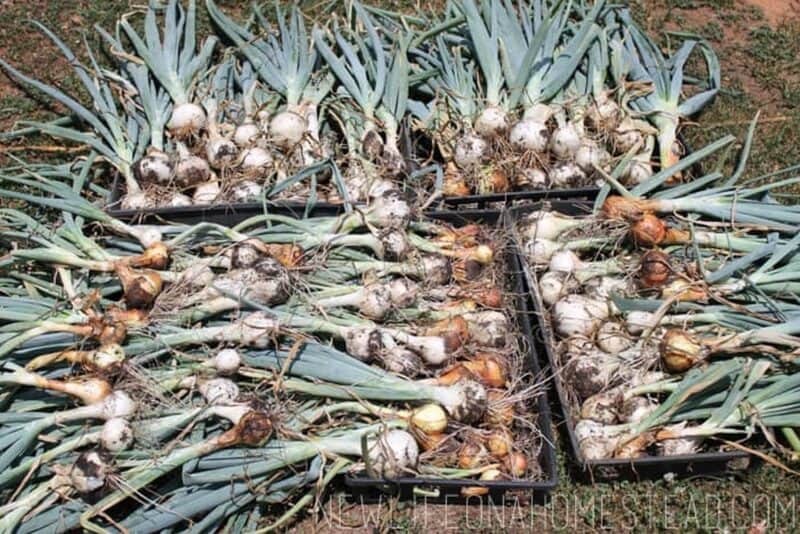
While onions do keep well simply in a bin or refrigerator, they can be just as easily preserved as the rest of the harvest yield so they last for months to years until they’re needed for use in the kitchen.
Preserving your onion harvest is definitely worth the small amount of time and effort it takes to complete this post-gardening task.
Table of Contents:
Quick Summary of the Preservation Methods
| Method | Estimated Shelf Life |
|---|---|
| Refrigeration | 2-3 weeks |
| Inside a root cellar | 8 months |
| Freezer | 1 year |
| Cooked and Refrigerated | 1 week |
| Pickled | 3 weeks if not canned and stored in the refrigerator; 6 months if canned |
| Canned (not pickled) | 3-5 years |
| Dehydrated | 10-15 years (6-12 months once opened) |
| Cured | 10-12 months |
| Caramelized | 2 months |
Type of Onions
- White Onions – This variety of onions is often described as being the mildest for eating either fresh or cooked into a recipe. To bring out the sweet and mellow taste of this onion before preserving, thinly slice them and soak them in cold water for roughly 60 minutes.
- Red Onions – These onions have a less sweet and more sharp flavor than white onions. Red onions give a beautiful color to any recipe that calls for onions, and are often used for grilling. This variety of onions also boasts a lower glycemic index.
- Yellow Onions – This variety is also commonly referred to as “Spanish” onions. They have a more distinct and sharp flavor than all other onion varieties and are often used for caramelizing.
- Sweet Onions – This type of onion is really a version of a white onion. Sweet onions have an increased sugar content than typical white onions. Many regions in America have their own native variety of sweet onions such as Vidalia, Maui, and Walla Walla.
- Green Onions – This type of onion is referred to as “scallions.” They are bunching onions that are typically harvested before they are mature, and the bulb truly starts to form so they can be eaten as greens. Scallions can be eaten raw or cooked just like any other type of onion.
Onions are commonly classified into two types: mild and pungent.
Mild Onions
- Vidalia
- Spanish
- Bermuda
- Walla Walla Sweet
Most Pungent Onion Varieties
- Copra
- Candy
- Ebenezer
- Red Weathersfield
While mild onions are juicy, large, and easy to peel, they are generally not good keepers. These are the type of onions most often tossed onto a cheeseburger or used to cook in soups and casseroles.
The quality of mild onions, even when properly preserved, often begins to diminish after a few months.
The best way to save and use mild onions for the long term is to turn them into pickles, chutneys, and salsa, and to caramelize them. Properly canned salsa will usually still be delicious for up to at least two years.
Pungent onions possess thinner rings and are almost always smaller in size than mild onions. Not surprisingly, it is the pungent onion varieties that tend to cause the most eye stinging and tears when cutting them.
It is the sulfurous compounds inside of onions that cause the eyes to swell up with tears. The more pungent the onion, the shorter its likely preservation period.
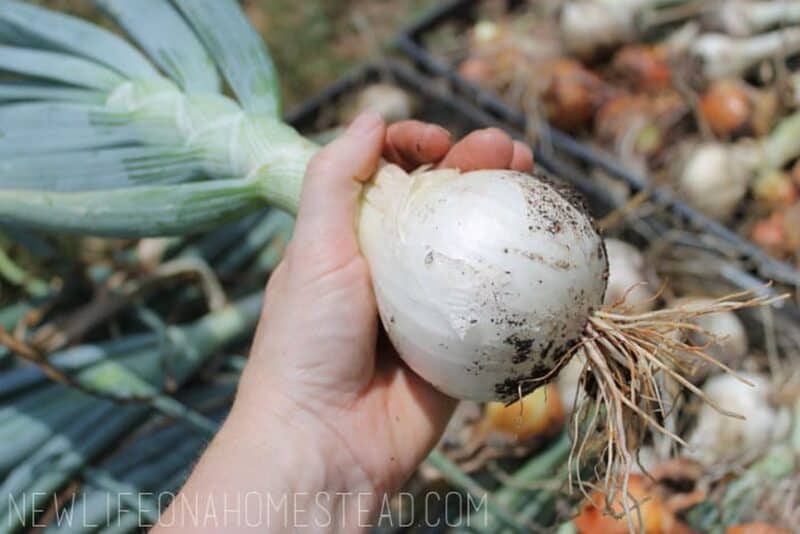
Do Onions Last Longer in the Fridge or on the Counter?
It may surprise you, but it’s actually better to store onions on the counter than in the fridge.
Relegating them to a drawer in the refrigerator will significantly reduce their shelf life. Onions need air circulation and warmth and flourish when stored at room temperature.
In order for them to last longer and stay fresher, keep them out of direct sunlight and away from heat sources such as stoves, ovens, and radiators.
Can You Preserve Store-Bought Onions?
Yes, if you need to supplement the onion harvest so you have a large enough batch to preserve you can use any type of onion from the supermarket.
Store-bought onions have already been cured, and have tougher skin than the ones picked fresh from the garden.
When the onions are cured excess moisture evaporates and helps to prolong the preservation process.
What is the Best Way to Harvest and Store Onions?
The best way to harvest and store onions is to wait until the leaves of the onion have turned yellow indicating that it is time to pick them.
After harvesting, individual onions should be cleaned up and then stored in a cool, dry place with good air circulation. If possible, storing them in a netted bag will help maintain airflow while preserving their crispness.
After harvesting and getting your onions inside, your next step is to figure out what to do with all of them. Keep reading to learn about some of the best options!
Top 10 Ways to Preserve The Onions Harvest
1. Refrigeration
- Average Shelf Life: 2-3 weeks
Store sliced onions in the refrigerator inside of a container, or a Ziploc bag. Never store whole or unpeeled onions of any type in the fridge because they will absorb far too much moisture.
Once onions absorb moisture they spoil a lot quicker and turn mushy. Onions can keep in the refrigerator for typically two weeks to 18 days.
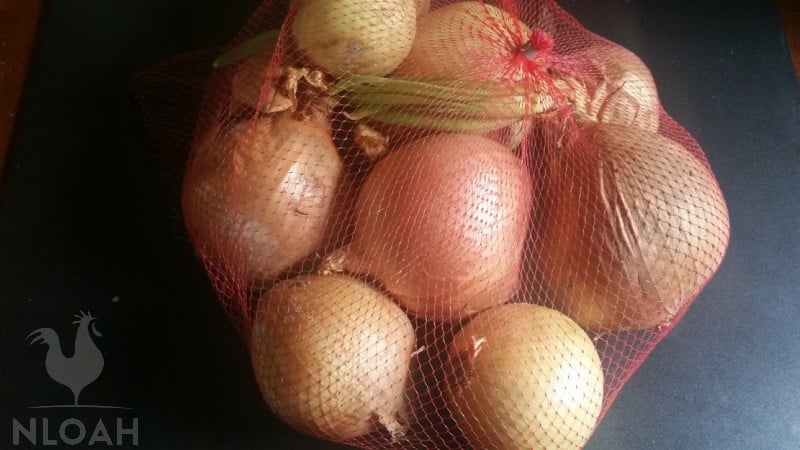
2. Cellar
- Average Shelf Life: 8 months
Storing whole unpeeled onions in a cellar or cellar-type cool and dark environment will also help preserve them.
As long as the cellar area (including a basement and unheated garages) is cool, dark, dry, and well-ventilated the onions should keep for approximately 8 months.
The cellar or similar style environment must stay at a steady temperature and above 32 degrees F (0 C) to avoid repeated freezing and thawing that can lead to mold and spoilage.
3. Refrigerated Scallions
Wrap cleaned scallions in a paper towel that is slightly damp and help together with a rubber band or piece of twine. Put them in the crisper inside of the refrigerator, and they will keep for about two weeks.
4. Freezer
- Average Shelf Life: 1 year
Scallions and all other varieties of onion can be chopped into chunks and frozen in an airtight bag or container. When washed and frozen onions should keep for approximately one year in the freezer.
Any onions that are not used after coming out of the freezer can be re-bagged and placed in the refrigerator – they should last at least one week under refrigeration.
5. Cooked and Refrigerated
- Average Shelf Life: 1 week
Pre-cooking onions so they are ready to use for a meal later in the week can be done without sacrificing quality or much longevity.
6. Pickled
- Average Shelf Life: 3 weeks if not canned and stored in the refrigerator; 6 months when canned
This traditional method of preserving a host of garden vegetables works quite well for onions, as well.
The pickling solution will thwart the growth of bacteria that causes food to go rancid. When pickled properly, onions can last a minimum of six months.
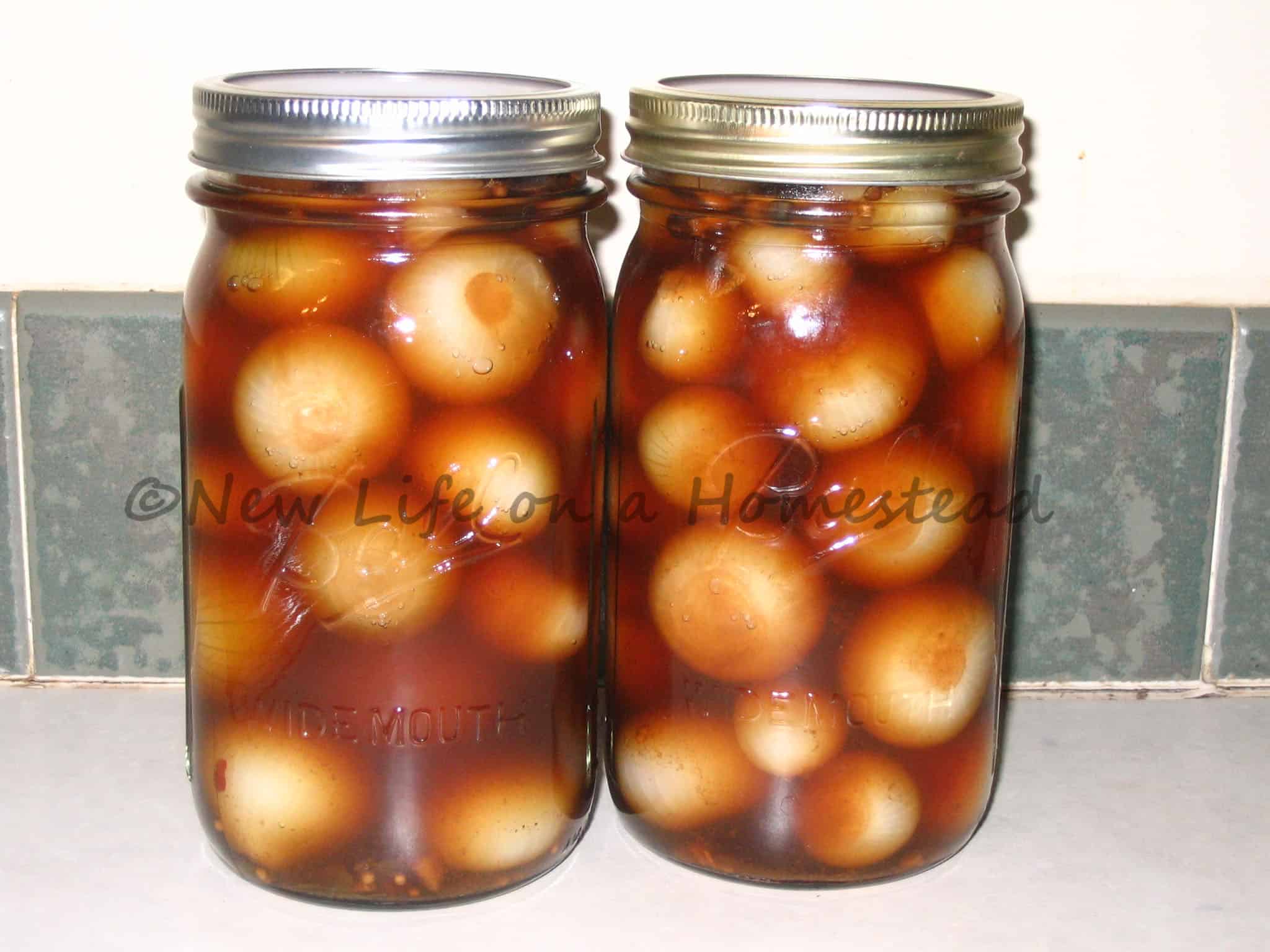
The onion pickling process is easy and inexpensive. Simply fill a glass Mason jar with ½ of a cup of apple cider vinegar, 1 thinly sliced onion (red onions are the most often pickled type but any onion will work) 1 cup of warm water, 1 and ½ teaspoon of salt, and 1 tablespoon of sugar.
Seal the jar so it is as airtight as possible, and allow the onions to soak up the brine and settle for at least 24 hours before eating or cooking with them. Store the pickled onions in a cool dark place to extend their shelf life.
7. Canning
Onions and other low-acid foods must be pressure canned and not water bath canned to deter harmful bacteria and microorganisms that will turn them rancid.
Onions must be pressured canned at 240 degrees to kill the deadly botulism bacteria.
To pressure can approximately 20 pounds of onions it will take 20 minutes of prep time and roughly 40 minutes of processing time. The peeled and washed onions can be canned whole if they are not large.
When dealing with large onions, it is best to chunk or slice them. If the onions are eaten like pickles, they are usually sliced into ½ thick rings.
Put the onion in a large cook pot (12 quart will be needed for 20 pounds) and cover them with water. Bring the onions to a boil over MEDIUM heat. Boil the onions for about five minutes, until they are translucent.
Remove the onions from the cook pot with a slotted spoon into the waiting sterilized Mason jars.
Pack the onions into the jars firmly – leaving only 1 inch headspace in each. Pour in the salt and the sugar before sealing the lid. Use the slotted spoon to release any air bubbles in the jars by pushing down onto the liquid.
Process jars filled with onions under 10 pounds of pressure for 40 minutes when using either quart or pint Mason jars. Remember to wait until the pressure gauge returns to zero and remains there for 10 minutes before removing the lid safely from the pressure canner.
Always refer to and follow all safe usage instructions on your pressure canner model before, after, and during use.
Learn how to can pickle onions here.
8. Dehydrating
- Average Shelf Life: 10-15 years (6-12 months once opened)
Dehydrating onions and storing them in vacuum-sealed bags or Mason jars will keep them shelf stable for years – when stored in a cool, dry, and dark place.
Dehydrating (or drying) onions in a food-grade dehydrating machine or in the oven will definitely make the room and plastic dehydrating trays quite stinky.
Chill the onion for about 10 minutes in the refrigerator to reduce the chances of them making your eyes water while cutting. Slice the onions as evenly as possible before dehydrating them so they dry both uniformly and thoroughly.
You can chunk or dice the peeled and washed onions as well – as long as they are uniformly separated. The drying process tends to take longer when the onions are chunked or diced instead of sliced into rings.
Place the onion parts onto the drying trays so that they do not touch. Dehydrate the onions on the 125 degree setting for approximately three to nine hours – until they are completely dry and snap when bent.
The onion scent will also linger on your dehydrating trays. To get rid of the smell, wash the trays in warm soapy water after pouring in a cap full or so of lemon juice into the dish water. It sometimes takes two washings to get rid of the onion smell from the tray.
To avoid the strong onion smell, you could dehydrate the onions outside in a solar dehydrator. The dried onion parts can be crushed into flakes and stored in a spice shaker.
To reconstitute dried onions, soak one part onions to two parts cold water in a bowl for 20 minutes.
9. Curing
- Average Shelf Life: 10-12 months
Spread the fresh from the garden onions onto drying racks out of direct sunlight or even the floor of the garage on a day when it is a consistent 75 to 80 degrees F (23 C to 26 C) and is not damp or humid.
The onions must be spread out in a single layer so they do not touch at any part. Handle the onions carefully to avoid bruising them.
Allow the onions to air cure for up to two weeks – unless the weather does not cooperate. The onions should not be moved during the curing process.
As the onions cure the skins will tighten around the vegetable and both feel and look “papery.” During this process, the necks will also start to wither.
Once the stems no longer contain any moisture and the necks are both dry and tight, use sharp scissors to trim the leafy portion of the onion down to within one inch of the bulb.
Once cured, store the onions in a bushel basket, cardboard box with some ventilation holes punched in it, mesh bag, or orchard rack.
If you want the onions to keep all winter, allow them to cure under proper weather conditions for four weeks. When stored in a dry, cool, and dark place the onions should remain safe to eat for 10 months to a year.
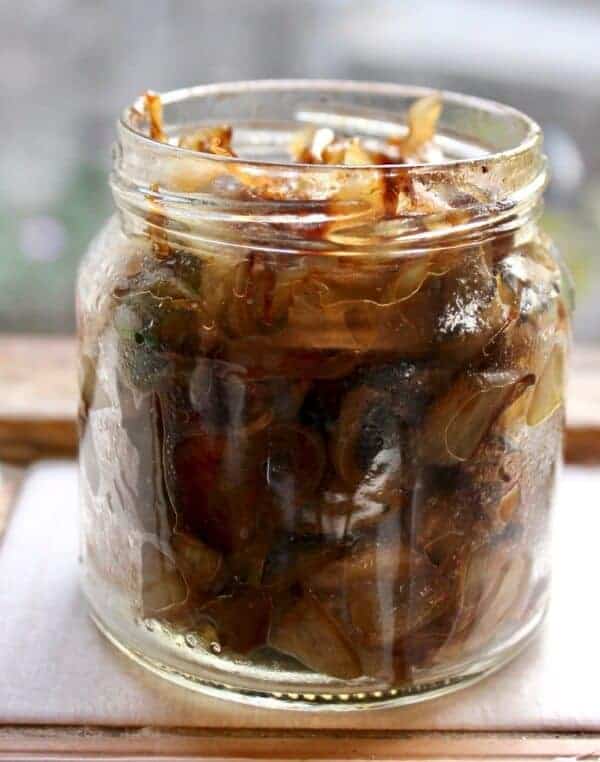
10. Caramelize
- Average Shelf Life: Two months
You can caramelize any variety of onion, but yellow and red ones tend to turn out the best. Red caramelized onions are often used as both a pizza and salad topping.
The “fond” is created as the onions cook in the skillet and release some of their sugar compounds and steam forms on the bottom of the skillet.
Folks sometimes think this means the onions are burning, but it is in fact the fond you want to create to essentially baste over the onions to caramelize them.
The fond is a glaze that dissolves when just a small amount of liquid is mixed with them. The steam generated from the frying onions creates the liquid you need when caramelizing.
Simply keep gently scraping and pouring the fond over the onions as they become dry and caramelized.
- In a cast iron or stainless steel skillet melt 2 tablespoons of olive oil or butter – or a mixture of the two.
- Stir in two to four medium-sliced onions.
- For the next five to 10 minutes check the onions and stir any fond that forms on top of them. The sugar compound percentage in the onions will play a big role in how long it takes the initial fond to form.
- At the 10-minute mark, the sliced onions should start becoming translucent and softening – releasing more steamy liquid into the skillet. Turn the heat down if you notice brown burnt spots on the onions starting to form.
- Continue checking on the onions to determine how they are processing. Around the 20-minute mark, a lot more spots of caramelization should be visible and more fond beginning to form in the bottom of the skillet. At this point, the onions should start to smell caramelized – especially if using sweet onions. Turn the heat down if you notice brown burnt spots on the skins of the onions.
- As you near the 30-minute mark, the onions should start to look a lot more like a jam and be a light blond in shade. A lot more fond should now be visible in the bottom of the skillet – and be easier to scrape up and pour over the onions, as well.
- At the 40-minute mark, the onions should definitely be smelling caramelized, and turning a golden color. Do a little taste test to determine if they are done, or need a few more minutes in the skillet.
- Once you are satisfied with the taste and texture of the caramelized onions, stir in the 2 tablespoons of water, chicken stock, balsamic vinegar, vegetable stock, or either red or white wine, and a pinch of salt to produce even more fond to pour over the onions.
- Allow the caramelized onions to cool and put them in an airtight container in the refrigerator for two weeks or freeze them in a similar container or Ziploc bags. Once frozen, the caramelized onions should keep for roughly two months without reducing their flavor. Simply chip off a bit of the frozen caramelized onions and allow them to thaw before use in a recipe or as a topping.
Another recipe for caramelized onions can be found here.
How Do You Save Onions to Plant Next Year?
Planting onions from saved seed is relatively simple and cost-effective, allowing the satisfaction of growing your own healthy, organic produce. To save onions for planting, select a few large, healthy onions that have stopped growing and let them dry in a warm place with good air circulation.
Once they are completely dry, carefully remove the papery outer layer and the tunic (onion skin) then separate any connected onion layers or bulbs.
Curl each onion layer or bulb into a tight circle and wrap in a paper bag to prevent them from drying out further – make sure to label the bag with the variety of onions that it contains.
Finally, store them in a cool, dark place until ready to plant outside in spring.
How Do You Store Chopped Onions for a Long Time?
The best way to do this is to keep them in an airtight container or bag, away from moisture and sunlight. Keeping onions refrigerated helps as cold temperatures stop them from sprouting and developing an odor.
Alternatively, you can freeze diced or chopped onions in a sealed tightly bag and use them within two months of freezing for the best flavor.
There you have it! Everything you need to know about storing your bumper crop of onions. Enjoy!
So, which of these preservation methods have you tried? Share your tips and comments below, and don’t forget to pin this on Pinterest!
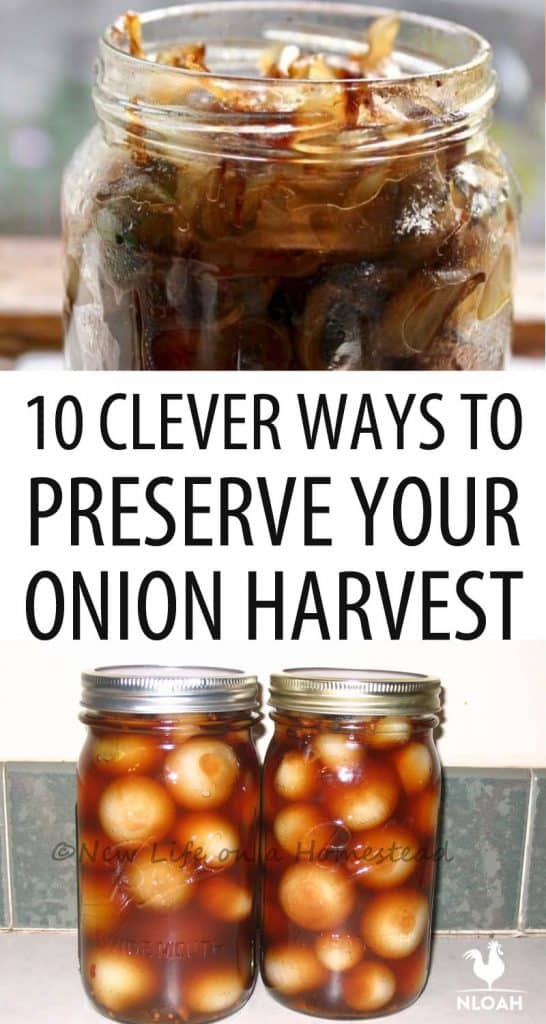

Tara lives on a 56 acres farm in the Appalachian Mountains, where she faces homesteading and farming challenges every single day, raising chickens, goats, horses, and tons of vegetables. She’s an expert in all sorts of homesteading skills such as hide tanning, doll making, tree tapping, and many more.
